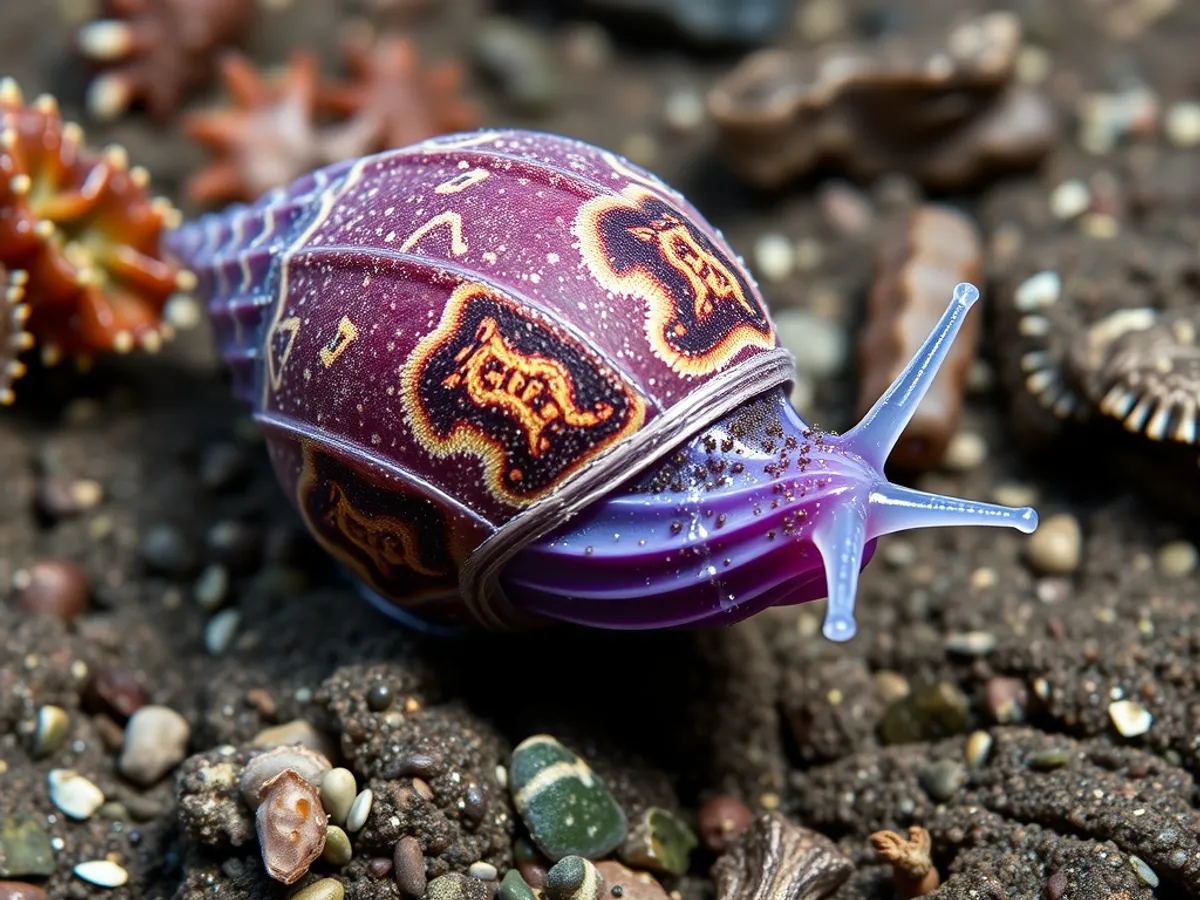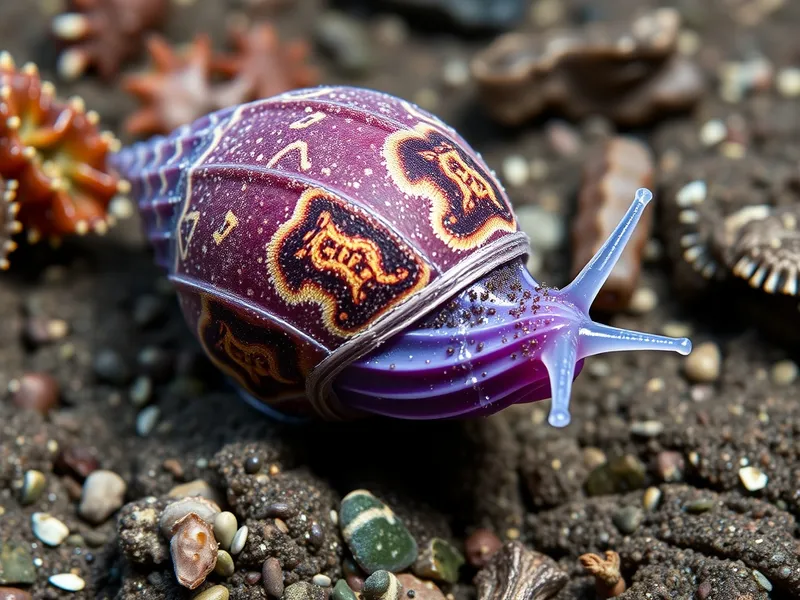
Violet Sea Snail
Janthina janthina

Meet the Violet Sea Snail
The Violet Sea Snail is a small, pelagic gastropod known for its striking violet-colored, paper-thin shell. This snail floats on the surface of warm ocean waters by creating a raft of bubbles, which it constructs using mucus. It is primarily found in tropical and subtropical seas worldwide, where it spends its entire life drifting with the currents. The Violet Sea Snail preys on floating cnidarians, such as the Portuguese man o' war, using its specialized feeding adaptations.
Classification
Invertebrate
Habitat
Open Ocean (Pelagic Zone)
Diet
Carnivore
Lifespan
1-2 years
Conservation
Least Concern
Weight
0.5-2 grams
📖Fascinating Facts
Purple Camouflage
The snail's violet shell helps it blend in with the colors of the ocean surface and the reflection of the sky, providing protection from predators.
Bubble Raft Architects
Violet Sea Snails secrete mucus to trap air bubbles, forming a raft that allows them to float upside down on the ocean's surface.
Pelagic Lifestyle
Unlike most snails, Janthina janthina never touches the sea floor and spends its entire life drifting in open water.
📋Detailed Description
The Violet Sea Snail (Janthina janthina) is a pelagic gastropod mollusk distinguished by its delicate, thin, and vividly violet shell, which typically measures 2–4 cm in diameter. The shell is lightweight and fragile, with a flattened spire and a glossy, iridescent surface. Unlike most gastropods, Janthina janthina is adapted for a fully pelagic lifestyle, spending its entire life floating at the ocean's surface. This is achieved through the production of a unique bubble raft, constructed from mucus secreted by the snail's foot and inflated with air, allowing it to remain buoyant. The snail's soft body is violet to purple, providing camouflage against the open ocean and matching the color of its shell. Janthina janthina is a specialized predator of neustonic cnidarians, such as Velella, Porpita, and Physalia (Portuguese man o' war), using a long, extensible proboscis to feed. It exhibits sexual dimorphism and sequential hermaphroditism, with individuals initially maturing as males and later transforming into females. The species is solitary but may be found in loose aggregations when food is abundant or during mass strandings. Its reproductive strategy is ovoviviparous, with females brooding eggs internally and releasing free-swimming veliger larvae. The Violet Sea Snail is distributed circumglobally in tropical and subtropical oceans, often seen in convergence zones where surface currents concentrate floating organisms.
💡 Did you know?
The Violet Sea Snail cannot swim and relies entirely on its bubble raft to stay afloat—if it loses this raft, it sinks and cannot survive.
🔬Research & Sources
🎭Behavior & Social Structure
Janthina janthina is primarily a passive drifter, relying on oceanic currents and wind to move across the pelagic zone. It spends its entire life at the air-sea interface, rarely diving below the surface. The snail constructs and maintains its bubble raft daily, adding new bubbles as needed to compensate for losses. Feeding is opportunistic; when a prey organism such as a siphonophore is encountered, the snail uses its proboscis to pierce and consume soft tissues, often ingesting nematocysts (stinging cells) without harm. There is no evidence of complex social behavior, but individuals may aggregate in areas of high prey density or during mass strandings caused by wind and currents. The snails are most active during calm sea conditions, as rough waters can disrupt their rafts and increase the risk of predation or stranding.
👶Reproduction & Life Cycle
Janthina janthina exhibits protandric hermaphroditism, meaning individuals first function as males and later transition to females as they grow. Mating occurs at the ocean surface, where males transfer spermatophores to females. Fertilization is internal, and females brood eggs within their mantle cavity. The species is ovoviviparous: embryos develop inside the female and are released as planktonic veliger larvae, which eventually settle at the surface and begin constructing their own bubble rafts. There is no parental care beyond brooding. Breeding appears to occur year-round in tropical waters, with peaks in larval release possibly linked to prey abundance and environmental conditions.
🛡️Adaptations & Survival
Janthina janthina's most remarkable adaptation is its ability to float using a self-constructed bubble raft, a rare trait among gastropods. The mucus used to form the raft is highly elastic and hydrophobic, allowing bubbles to persist for extended periods. The snail's violet coloration provides countershading: the darker dorsal side blends with the ocean depths when viewed from above, while the lighter ventral side matches the sky when seen from below. Its radula and proboscis are specialized for piercing and consuming gelatinous prey. The species is also resistant to the toxins of its cnidarian prey, allowing it to feed on otherwise dangerous organisms. Sequential hermaphroditism increases reproductive flexibility in the sparse pelagic environment.
📚Research Sources
🎨Cultural Significance
The Violet Sea Snail has limited direct significance in human culture due to its remote, oceanic habitat and small size. However, its striking appearance and association with the Portuguese man o' war have made it a subject of interest among beachcombers and naturalists, especially when mass strandings occur. In some cultures, the shells are collected for decorative purposes or as curiosities. The snail's unique adaptations and vivid coloration have inspired scientific curiosity and featured in educational materials about oceanic biodiversity.
🔬Recent Research & Discoveries
Recent research has focused on the molecular composition of Janthina janthina's mucus and its role in bubble raft formation, revealing unique glycoproteins and surfactant properties. Studies have also examined the snail's resistance to cnidarian toxins, with implications for understanding toxin sequestration and immunity in marine invertebrates. Genetic analyses are clarifying the evolutionary relationships within the Janthinidae family and the origins of pelagic lifestyles in gastropods. Ongoing research is investigating the impact of microplastics and changing ocean chemistry on the snail's physiology and distribution. Citizen science projects and beach surveys are helping to document mass strandings and improve knowledge of population dynamics.
🎥Wildlife Videos

Purple Sea Snail facts: the "bubble raft" snail | Animal Fact Files
Purple snails, or purple sea snails, are called so because they come in shades of purple! They are also known as violet snails for ...
Animal Fact Files

Meet the Ocean Creature Feature: The Violet Sea Snail
Meet the Ocean

The Deadly Cone Snail | World's Weirdest
#NatGeoWILD #ConeSnail #WorldsWeirdest About World's Weirdest: This amazing series showcases the strangest, freakiest, ...
Nat Geo Animals

Giant Sea Snail Hunting Crown-of-thorns Starfish
The Giant Triton is one of the ocean's largest sea snails. Tritons can measure nearly half a meter from tip to tail. This giant ...
Love Nature

Giant Snail Uses "Snorkel" to Breathe Underwater | How Nature Works | BBC Earth
Floods are slowly suffocating the Pantanal's ecosystem, but luckily, these ingenious water-breathing snails might be able to save ...
BBC Earth

Sea Snail - 5 Minute Documentary
Dive deep into the mesmerizing underwater realm with a captivating five-minute documentary that unveils the fascinating world of ...
Five Minute Documentaries
🌍Habitat Information
The Violet Sea Snail typically inhabits Open Ocean (Pelagic Zone) environments. Violet Sea Snails have adapted to their environments with specialized features and behaviors.
Primary Habitat:
Open Ocean (Pelagic Zone)
More detailed habitat information will be available soon.
🛡️Conservation Status
The Violet Sea Snail is currently classified as Least Concern. Conservation efforts are crucial for preserving this species for future generations.
Common Threats:
- 🏠Habitat loss and fragmentation
- 🌡️Climate change impacts
- 🎯Hunting and poaching
- 🏭Human-wildlife conflict
⚠️Threats & Conservation Challenges
While Janthina janthina is currently listed as Least Concern, it faces several ecological challenges. Its fragile shell and dependence on surface rafts make it vulnerable to rough seas, storms, and wind-driven strandings. Climate change and ocean acidification may affect the snail's ability to produce and maintain its shell and bubble raft. Pollution, particularly oil spills and plastics, can disrupt surface-dwelling organisms and interfere with feeding and flotation. There is no evidence of targeted human exploitation, but bycatch and habitat changes could impact populations locally. Long-term population trends are poorly documented due to the snail's pelagic lifestyle.
🔬Scientific Classification
Scientific Name
Janthina janthina
Classification Hierarchy
🔍 About Taxonomic Classification
Taxonomic classification is a hierarchical system used by scientists to classify and organize living organisms based on shared characteristics and evolutionary relationships.
The system moves from broad categories (Kingdom) to increasingly specific ones, with each animal's scientific name typically consisting of its Genus and species.
📝Community Notes
Share your observations and insights about the Violet Sea Snail with our community of wildlife enthusiasts.
Join Our Community
Sign in to share your observations and connect with fellow wildlife enthusiasts.
Sign In to ContributeNo community notes yet
Be the first to share your observations about the Violet Sea Snail!
Explore Violet Sea Snail
Select a tab above to learn more about this amazing animal.
📸Photo Gallery
No photos available for this animal yet.
🌟Discover More Wildlife
Continue your journey of discovery with more fascinating animals from our database
